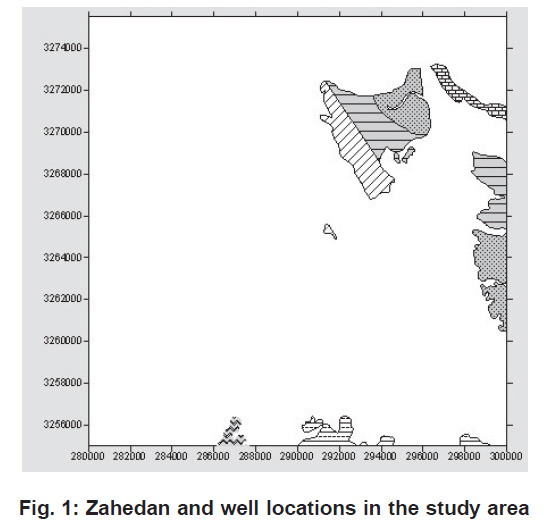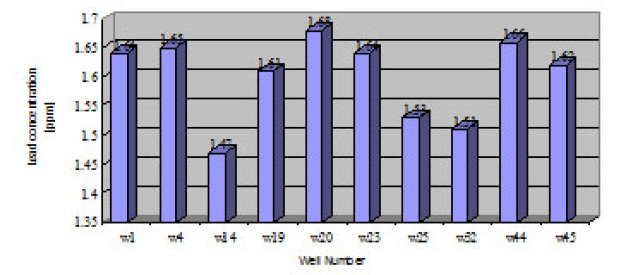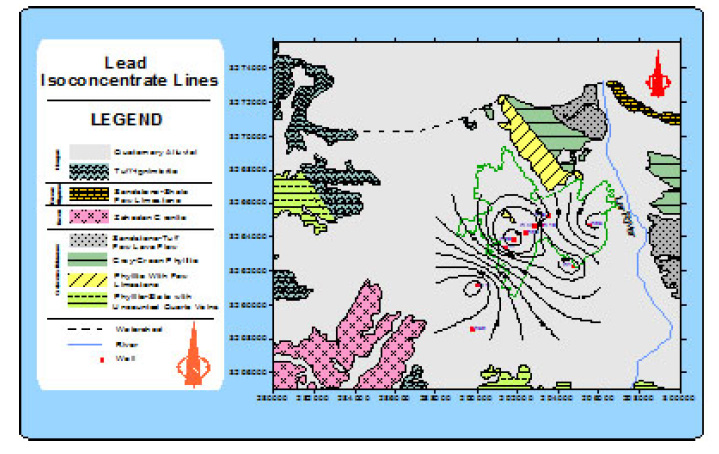The Magnited of Lead in Zahedan Groundwater
Hossein Atashi1 * , Nargess Rahimi2 and Farrokh Akbari Espaili3
1
Chemical Engineering Department,
University of Sistan and Baluchestan,
Zahedan,
Iran
2
Islamic Azad University (Birjand Branch),
Iran
3
Chemical Engineering Department,
University of Sistan and Baluchestan,
Zahedan,
Iran
DOI: http://dx.doi.org/10.12944/CWE.5.2.01
Copy the following to cite this article:
Atashi A, Rahimi N, Espaili F. A. The Magnited of Lead in Zahedan Groundwater. Curr World Environ 2010;5(2):223-227 DOI:http://dx.doi.org/10.12944/CWE.5.2.01
Copy the following to cite this URL:
Atashi A, Rahimi N, Espaili F. A. The Magnited of Lead in Zahedan Groundwater. Curr World Environ 2010;5(2):223-227. Available from: http://www.cwejournal.org/?p=1179
Download article (pdf)
Citation Manager
Publish History
Select type of program for download
| Endnote EndNote format (Mac & Win) | |
| Reference Manager Ris format (Win only) | |
| Procite Ris format (Win only) | |
| Medlars Format | |
| RefWorks Format RefWorks format (Mac & Win) | |
| BibTex Format BibTex format (Mac & Win) |
Article Publishing History
| Received: | 2010-07-10 |
|---|---|
| Accepted: | 2010-08-25 |
Water is our essential nutrient that contains different amounts of dissolved inorganic and organic compounds. We can survive weeks even months without food, but only less than four days without water. Water play main role in digestion, circulation and transporting of nutrients in our body, also carrying away waste from our body. About 50 percent of water that we use provide from ground water, so it is necessary we sure from its safety. Provide of fresh water is one of basic problem in our modern world and this problem is very serious in country such as IRAN that located in dry and semidry region.
Zahedan city is located in south east of Iran close to Pakistan boarder that fresh water is provided mainly in ground water. Rapid growth, development, scare resources, small aquifer, low rain fall and high vaporization rate has been characterized this region from other part of Iran. Toxic organic material, heavy metals is common problem of ground water in this city that damages the water quality. Heavy metals are described as components of the earth crust that can not be destroyed. They enter our bodies via food, drinking water and so on. Some heavy metals at trace magnitude are essential but at high concentration can be poising.
Lead is one of heavy metal which found in trace amount in live organism in unwanted and present in soil, water plants and animals and plays no role in organism. Lead used since ancient times by human for cosmetic and medicine purpose but today it used in drinking water, leaded gasoline, tire wear and lubricating oil. This element is resistant to corrosion and many civilization used it for many application for example to transport water. Lead used for lead pipe line, lead solder and fixtures .Lead has used as brass and bronze alloys and other uses. Some commercial use of lead are in batteries, paints, glass ,pigment, and enamels. Because of extend application in many industries the concentration of this element in blood in some country exceeds 50 to 200 times more than ancient time. Lead contamination in water and wastewater, which resulted from many industries such as metal plating, mining and tanneries, is a serious problem due to the poisoning effect on humans and to the other adverse effects on receiving water.1
Live, kidney cortex and medulla is most storage site of lead but toxic effect of this element may affect various organs system in human and animal bodies. There is two way that may be lead enter to our body: swallow and breathe. Although we consider this metal as one of health threat to human especial for children, Even at low levels ,lead may cause a range of serious effect on human health special on younger people. This metal can affect every organism in human and animal bodies. Children under six year for developing their brain,and pregnant woman are most sensitive and at risk.
Also kidneys and reproductive system include the organ that may be at risk. At high concentration of lead exposure ankles, wrists and fingers may be weakness. Lead may decrease the ability of memory and cause cancer in human and animals .other Lead poisoning symptoms are headaches, tiredness and insomnia, Loss of appetite, stomach pain, Pain, and weakness or twitching in the muscles,2,3 and also could cause decrease in sex drive and birth defects, kidney damages, permanent brain and nerve damage, drowsiness, runny nose, sore throat, watery eyes, itchy skin and nausea or vomiting, sweating, salivation, and blurred vision or myosis4,5 and in children can cause death.6 A number of techniques have been developed for removing lead pollutant from aqueous effluents to minimize its impact. These methods include precipitation, electroplating, evaporation, ion exchange, membrane separation, adsorption and various biological processes. Among these methods, adsorption, which can remove trace amount of lead pollutant from aqueous solution.
Experimental
For measure lead concentration in ground water in zahedan we collected water samples randomly from 10 wells in different places and directions in city. Part of Zahdean drinking water has provided from this wells. Sampling has done ten times. Map of this area and the wells locations are shown in figure (1). This figure is drawn by use of surfer software. For sampling plastic bottles were used and for sample stability we added concentrated nitric acid to pH of samples reached to 2.
We used plastic bottles for sampling. First, the bottles were washed carefully and then the samples were collected. We reached a pH of two for each sample by adding immediately the concentrated nitric acid to stable samples. The methods of experiment have been adopted from National Exposure Research Laboratory, U.S. Environmental Protection Agency, Athens, GA7. Analysis of the samples has been done based on “Standard Methods for the examination water and wastewater” book (1999).
Analysis of elements in samples has been done in Sistan and Baluchestan geological and mining exploration organization laboratory. These measurings have been done by the flame atomic absorption spectrometer, SpectAA-22o that is made in Varian Australia. The flame atomic absorption method was used to measure lead and cobalt concentrations and cold vapor generation method was used to measure mercury concentration.8-10
Results and Discussion
We have shown the results of measured elements concentrations in the histogram diagrams (figures 2, 3, 4) and compared these measures. These figures have been drawn by use of Excel software. Isoconcentration contours are drown on a map of this area by Surfer software to study distribution system of concentration and recognize.
 |
Figure 1: Zahedan and well locations in the study area Click here to view figure |
 |
Figure 2: Comparing the lead concentration in sampling wells Click here to view figure |
 |
Figure 3: Lead isoconcentration contours (ppm) in the region Click here to view figure |
The pollution origins, by using geological map of the area10 , the Geographical Information System (GIS) of the sampling wells, and the concentration amounts of these elements.
Lead
The histogram diagram in figure (3) illustrates that minimum of the measured lead concentration was in the well w14 (1.47 ppm) and the maximum was in the well w20 (1.68 ppm). According to the standard of the world health organization (1993), the lead standard authorized limit for drinking water is 0.01ppm10, that the lead concentration was more than standard authorized limit of concentration in all samples. Figure (6) shows the lead isoconcentration contours in the case studies. Two anomalies were observed, one in the well w1 at the beginning of Mirjaveh road and another near the well w20 in Behdasht Boulevard (city center). Near the well w1 an industrial town and a waste burying place were observed and around the well w20 no pollutant agent (include human and industrial agent) was observed. In addition, one industrial town was located in the northwest.11 The effect of Taftan and Bazman volcanic activities produce lead ore in granite bulks that diffuse in sediment stones.12 As there is not any industrial town, we can say that geological situation in this area is the main reason of high concentration of pollution in Zahedan aquifer and local human activities in these regions cause the production of pollutants. Another resource of lead concentration is the air pollution in cities, which is solved by acid rain and goes into the ground water and surface water.
Conclusion
Concentration of the two pollutants (lead and cobalt) in all the area are much more than the standard authorized limit like the lead concentration that is about 150 times more than standard authorized limit. However, mercury concentration in the center and south of the city is more than the standard authorized limit.
Studies show that the main source of pollution is around the wells w20 and w4in the center of the city (Behdasht and Janbazan Boulevard). Not any other pollution resources have been observed in this part of the city; therefore, the origins of pollution are geological and existence of these elements ores in this region. In this area, places where pollutions have human origins are Mirjaveh industrial town, Workshop industrial town and the waste burying place of the city. These industries are small; consequently they do not play much role in these pollutions. However, Mirjaveh industrial town and the waste burying place of the city have much more pollutant share due to Workshop industrial town. Although this effect is very little now, but it causes pollution increase in this area that an
anomaly around the well w1.
Generally, the effects of geology in heavy metals pollution observed in all parts of the region and human activities cause some of these pollutants enter aquifer locally. Industries do not treat their wastewater and let it to the environment.
Comments
- High concentrations of some elements make drink groundwaters in this area dangerous. Unallowable amounts of heavy metals, suggest that the water of aquifer first be treated and then used for drinking.
- To prevent more pollution of the aquifer, a general program performs the industrial and workshop wastewater treatment of the industrial towns. Moreover, strict supervision have to be done over the new plants for wastewater treatment in three industrial towns and out of these in Zahedan by Iranian department of environment. It is necessary to control industries.
- Generally, geological situation in Sistan and Baluchestan region causes the ore variety and multiplicity in this region. This variety is so much that makes Sistan and Baluchestan as a different and remarkable region in Iranian geology. Therefore, it is recommended that an expert group of economists, economical geologists, geochemists and hydrogeologists study the qualitive and quantitive effects of geology on the elements and especially existence of heavy metals in ground water in this region.
References
- X. Song, H. Liu, L. Cheng, Y. Qu, J.of Desalination. 2010;255:78.
- K. Dietrich, D. Bellinger, The assessment of neurobehavioral development in studies of the effects of prenatal exposure to toxicants. In: Prenatal Exposure to Toxicants: Developmental Consequences. 1994;57.
- Jacob, J. wakley, Removal of Heavy Metals from Waste Water, Brigham Young University. 2000.
- M. Ahmadi Zadeh, Industrial Toxicology of Heavy Metals, Hezaran Publishing Company. 1997.
- Handbook on Children’s Environmental Health, American Academy of Pediatrics. 1999;(888)227-1770.
- P.A. Bertrand, P.D. Fleischauer. X-Ray Photoelectron Spectroscopy Study of the Chemisorption of Lead Naphthenate to Nucleophilic Surfaces. The Aerospace Corporation. El Segundo, California. Report Number SD-TR. 1980;80-66.
- E. J. Weber, J.M. Washington, Summary of the Environmental Fate of Organometallic Drying Reagents in Landfill Environments. Memorandum. Ecosystems Research Division, National Exposure Research Laboratory, U.S. Environmental Protection Agency, Athens, GA. 2000.
- ASTM Standards. Water and Environmental Technology. No. of Methods (D 1688, D 3559, D 3919. 1999.
- Mulgrave, Victoria, “Analytical Methods, Flam Atomic Absorption Spectrometry”, Varian, Australia. 1989.
- Varian, “VGA Manual Varian”, Australia. 1997.
- Guide Line for Drinking Water Quality, Word Health Organization Standard”. 1976.
- UK Department of the Environment. Transport and the Regions, Drinking Water Inspectorate. 1998.






